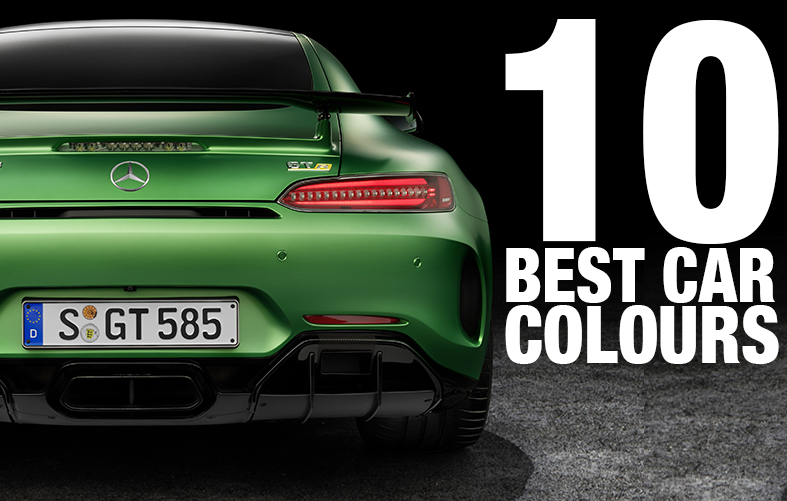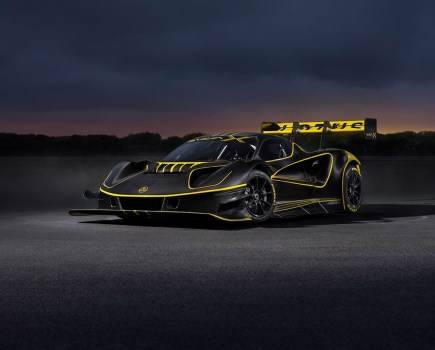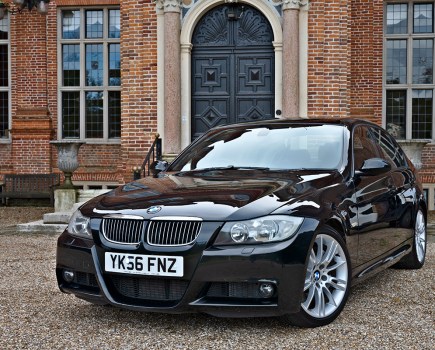When did the world turn greyscale? Look out of the window right now, we can guarantee that about ninety-percent of the cars you can see will be white, black or silver. Where’s the fun in that? We check out the best 10 car colours from OEM.
It used to be the case that the most popular choice was ‘resale red’, but the buying public are far too conservative these days.
That’s not to say that manufacturers aren’t having their fun, of course. While the Smiths next door may be most likely to spec their Qashqai in something anonymous and inoffensive, there are still plenty of unusual paint shades populating the colour charts if you dig deep enough; the enduring popularity of matte and satin finishes means that BMW will happily sell you an M4 in Frozen Grey, Bentley offer a host of premium satin hues, while Ferrari reckon their new matte red option isn’t for aesthetics, but is in fact ‘a weight-saving measure’ (yeah, right).
On the shinier side of things, bright yellow’s made a comeback – you can buy a Nissan Juke in the same shade that British Telecom used to paint their vans in the eighties, for some reason – although the overriding enthusiasm among the buying masses these days is for grey. People just can’t seem to get enough of it.
But there’s more to paint than fashions and fads… here’s our pick of the best 10 car colours from manufacturers. And this really took some narrowing down – we could have done a top ten of the blues alone; Mazda’s Mariner Blue, Nissan’s Bayside Blue, Audi’s Nogaro Blue… but we had to be ruthless. Take a look at our final countdown and see if you agree!
Best 10 car colours
Rubystone Red
This timeless Porsche shade is red in the same way that Triumph’s Nuclear Red is red. Which is to say it’s not red at all, it’s pink. But shhhh, you’ll upset the Porsche Owners Club if you say that…
The marque has a long history of offering their more boisterous models in appropriately shouty shades, like Viper Green and Mexico Blue, but it takes true strength of character to spec your car in bright pink and then go around telling everybody it’s actually red. You can imagine the Paddington-like hard stare you have to give as you say it.
Bloody strong choice of colour though, isn’t it? It looks especially awesome on the 964, particularly the extravagantly bewinged RS models, and there’s one moneyed lunatic out there who’s even repainted an ultra-rare Carrera GT supercar in this astonishing splash of raspberry.
But it’s not red. Don’t let them fool you. Rubystone Red is pink. And while most pink cars look hideous, these Porsches always just look achingly cool, and that’s why it’s on our list of the best 10 car colours.
Nardo Grey
Oh look, it’s a shade of grey. Well, we sort of had to add it to our list of the best 10 car colours really, didn’t we? So-called ‘shiny primer’ burst onto the scene a few years back and it’s proved incredibly successful: Ford offer the Focus in Stealth Grey, and the Fiesta ST200 had a special Storm Grey, Porsche can sell you a 911 in Crayon Grey or Fashion Grey, but the daddy of them all (and the one we’ve seen sprayed onto countless project cars lately) is Audi’s Nardo Grey.
For around five years, four-ringed high-performance models have been offered in this now-iconic hue – the R8, RS3, RS4, RS5, RS6, they’ve all been slathered in it and the buying public just can’t get enough. It’s a polarising colour choice, as the majority of people really, really like it, but those who aren’t fans can be properly scathing, asking why you’d put so much effort into polishing the primer instead of painting it a real colour. Which is a bit mean-spirited, we reckon. Live and let live, let’s enjoy it and surf the swelling tide of grey – after all, on the right car (and in particular, the right Audi) it looks completely awesome.
Liquid Yellow
Here’s an example of how the right colour can totally transform a car. You see, traditionally-speaking Renault were never that adventurous with their colours; back in the day you could have your Mk1 Clio or your 19 16v in Williams Blue, which was attractively sparkly, but aside from that there wasn’t a lot of excitement on the palette.
This changed with the advent of the Clio V6, an insane mid-engined brute which, weirdly, you’re most likely to spot painted in a boring shade of silver. But Renaultsport also decided to offer it an incredible new shade called Liquid Yellow, which turned out to be a bit of a game-changer. It was exactly the sort of boisterous look the V6 Clio needed, and the colour’s been a stalwart of the Renaultsport range ever since. You can see why – it’s not just yellow, it’s REALLY, REALLY YELLOW, and there’s a gorgeous pearlescence to it that shimmers through gold and silver and all sorts in the light.
It’s no surprise that Tom at Meguiar’s chose this colour for his 5 GT Turbo in the build-off – those old-school hot hatches shouldn’t have been sidelined with anonymous reds and blacks and whites, Liquid Yellow is exactly what a lunatic hot hatch deserves.
Midnight Purple
Nissan’s R33-generation Skyline GT-R was a pretty astonishing thing. While the R32 that came before it came to be known as ‘Godzilla’ when it proved to be utterly unbeatable in Touring Car racing (and, quite possibly, because it ate Tokyo), the R33 was even more mental. It was lower, wider, more technologically advanced, and a full 21 seconds quicker around the Nürburgring.
And when a car’s this bonkers, it needs a bonkers colour to herald its arrival, and that’s exactly what Midnight Purple was. It’s become a fan favourite over the years, with its magical ability to look like entirely different colours in different lights – a vibrant Cadbury purple in bright sunshine, yet almost black when it’s in the
dark shadows.
The fun part, which a lot of people don’t realise, is that it actually was a bunch of entirely different colours. Nissan did three separate versions – LP2 Midnight Purple, LV4 Midnight Purple II (which appeared on the R34 and had a bluish tinge), and LX0 Midnight Purple III (which seems almost green from some angles). Each variant is legendary though, and it’s so typically Japanese to make slightly different versions just to confuse people. We love that.
Championship White
It’s interesting how white has changed in popularity over the years. Back in the 1980s and ’90s white cars were the cruddy base models – you only had that if you were too cheap to shell out for a proper colour. You could get a rattle-can of Appliance White from the local motor factors, the same colour of paint you’d find on your washing machine, and that’d be good enough to touch up pretty much any white Nova or 205. But then, about fifteen years ago, manufacturers started painting their high-end concept cars in carefully-formulated new mixtures of white, and everything changed: suddenly every single fully-loaded Audi on the street was finished in white. It became a mark of class and taste.
The godfather of them all, however, has to be Honda’s Championship White. Over at Honda, white never equated to either cheapness or luxury, it was always about motorsport. And Championship White was the signature colour for the Type R factory hot rods: the EK9 Civic, the NSX-R, the DC2 Integra, they all came out swinging in this crisp, pure-as-driven-snow paint. It may have been absent from the UK-spec EP3 Civic line-up but the higher-spec JDM variant was resplendent in Championship White, and it’s something you can choose on a brand new FK8 Civic today. It’s the colour of hardcore road-racers and that’s why it’s on our list of the best 10 car colours.
Green Hell Magno
Putting ‘hell’ in the name of anything is bound to make a statement. It’s important to point out, however, that the third word in this particular paint name is ‘Magno’. We’re not looking at Green Hell Mango, although that would be a much more amusing name to bandy about.
This is a colour specifically formulated for the AMG GT R, which is itself a pretty terrifying car. Honed and refined at the Nürburgring, that’s naturally the source of the ‘Green Hell’ part of the name (it was the nickname given to the Nordschleife by Jackie Stewart in the 1960s) – but the ‘Magno’? Well, it’s the name of a Mexican wrestler, or a slang term for a snitch, or… well, your guess is as good as ours, really. Sounds good though. And the colour itself is absolutely magnificent – you wouldn’t think that a froggy cartoonish green would work on a super-coupé, but there’s something about that frosty finish that means we just can’t tear our eyes away.
Impressively, Green Hell Magno paint is a £7,500 option on the GT R. So it’s not just a colour, it’s an expression of very, very deep pockets, hency why it’s on our list of the best 10 car colours.
Cascade Violet
TVRs have always been a bit mental. When all other sports car manufacturers in the 1990s and early 2000s were making great efforts to boast about their superior crash structures and advanced accident avoidance systems and what-have-you, TVR basically waved two fingers at the concept of safety and reasoned that if you were dumb enough to crash, you were on your own. So they shoehorned massively powerful engines into lightweight fibreglass bodies, didn’t bother adding any of that namby-pamby stuff like ABS or airbags or traction control, and sent their customers out into the wild with their fingers crossed.
With such a mad attitude comes mad cars, and the styling of the era was borderline insane: the Cerbera, Tuscan, Sagaris, Tamora, T350C and all the other TVRs that arrived on the scene offered riotous fusions of curves and slashes and oblique angles, more like spaceships than cars. And of course they had mad paint to suit – we’ve picked Cascade Violet as our favourite here, as it phases improbably between purple, blue, green and gold depending on where you’re standing, but TVR had a whole range of these colour-shifting options. They offered five different types of multicolour paint finishes – Chameleon, Reflex, Nebula, Cascade, and Spectraflair – and each one could be subdivided into a near-infinite galaxy of choices; Chameleon Orange, Cascade Indigo, Reflex Burnt Olive, it was never-ending.
These shapeshifting finishes were very much at the cutting-edge of paint technology at the time: the cruise scene was rife with Cavaliers and Escorts painted in Chromaflair, and Nissan themselves even got in on the action, offering factory chameleon paint on the Primera and Micra. Which looked great in the showroom, but turned into a total pain in the arse when the old biddies brought their Micras back to the dealership to have the paint on the bumpers touched up after the inevitable car park dings. Turns out that if you want your car to be eight different colours at once, it’s quite hard to paint.
Silver Birch
It’s a weird quirk of the automotive world that silver cars usually look a bit crap and cheap. In all other aspects of life, silver is aspirational and premium and fancy; plus, as is the nature of human beings, we just love shiny things. When it comes to cars though, silver often denotes a base model, a cheapo basic colour that the buyer didn’t specifically choose, they just received it by default.
We can make a clear exception for Silver Birch, however. This is a silver among silvers, an all-time classic, an icon. It’s the colour that James Bond’s Aston Martin DB5 was painted, and there aren’t a lot of cars cooler or more desirable than that. C’mon, it had rocket launchers and bulletproof shields, the number plates rotated to displays tags from different European countries, it could deploy an oil slick at will. It had an ejector seat! It had sat-nav, in the 1960s!
Yes, Default Silver is a bit rubbish. But 007 Silver Birch? That’s in a whole other league, which is why it’s in our list of the best 10 car colours.
Citrine Yellow
It might be the fact that it’s sunny outside and we can’t stop dreaming about beer gardens, but we’ve had to stick another shade of yellow in our top ten. This one, Citrine Yellow, is an oh-so-nineties effort with a peppy vibe and an up-and-at-’em attitude. It’s the colour you would have found slathered on the Mondeo Si, and it was wholly appropriate in that context; you see, Ford had been having a bit of trouble getting buyers excited about sporting variants of the executive saloon/hatchback.
Sure, the Mondeo was shifting units in incredible numbers, but it didn’t exactly scream ‘sports car’ on the school run or in the supermarket car park. Ford’s answer? Bolt on the full RS bodykit, whack in a shorter-ratio gearbox to go with the 2.0-litre motor, and paint the thing in a ridiculous new colour called Citrine Yellow, a sort of vibrant lemon-lime affair. These cars were farmed out to dealers to act as demonstrators (Hendy Ford got fully into the idea and rebuilt the engines with different cams to squeeze out some more grunt), and the public really took to the idea.
At the height of 1990s car modifying culture, suddenly everyone wanted to paint their own fibreglass-clad Nova or Golf in Citrine Yellow. Ford probably made more cash off the paint sales than they did from the Mondeo Si itself. Smart move. And deserved of a position on our best 10 car colours list.
The entire late-1960s/early-1970s Chrysler colour chart
Muscle cars were famously ostentatious, that was the whole point of the genre. You take a sensible-ish saloon platform, drop a rakish coupé body on the top, then shove a stupidly massive V8 under the bonnet. Handling didn’t matter as these cars were essentially built for one thing and one thing only: to go as fast as physically possible in a straight line for a quarter of a mile, before asking Peggy-Sue to hop in the passenger seat to cruise down to the diner, then the drive-in, then hopefully to Inspiration Point.
The Chrysler Corporation understood this whimsical nature better than most, and the colour charts for their Mopar muscle cars were positively brimming with iconic and wonderfully-named ‘High Impact’ paint shades: Top Banana, Sub-Lime, Go Mango, Plum Crazy, Sassy Grass Green, Panther Pink, Vitamin C Orange, Citron Yella… and that was all in addition to the forty-or-so standard colours available. If only today’s manufacturers could be that silly. We had a look at the paint chart for the Polestar 1 and, as cool a car as that is, you’ll literally only get it in black, white or grey. Bring back the crazy, we say!







